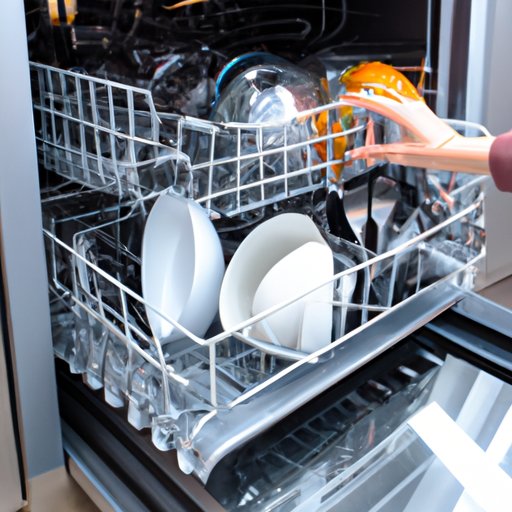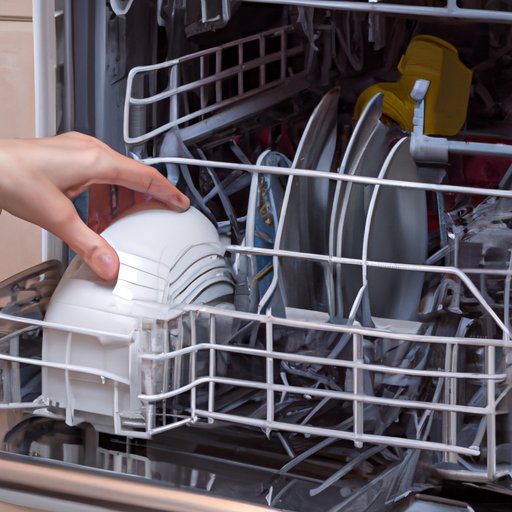Introduction
A dishwasher is a kitchen appliance that cleans dishes by spraying them with hot water and detergent. It is designed to make cleaning up after meals easier and faster. Many modern dishwashers come with a range of features and settings that allow users to customize their cleaning experience. Most dishwashers are built-in models that are installed under the kitchen counter, but there are also smaller portable and countertop models available.
The main components of a dishwasher include a spray arm, a heating element, a pump motor, a timer, and a detergent dispenser. The spray arm sprays hot water onto the dishes to loosen dirt, while the heating element heats the water to the right temperature. The pump motor pumps the water through the dishwasher, while the timer controls the length of the wash cycle. The detergent dispenser releases detergent into the water during the wash cycle.
Using a dishwasher has several advantages compared to hand washing dishes. First, it saves time and energy because the dishes are cleaned quickly and efficiently. Second, it uses less water than hand washing dishes, which helps conserve resources. Finally, it can help reduce bacteria on dishes since the hot water used in the dishwasher kills germs and bacteria more effectively than cold water.
Step-by-Step Guide to Operating a Dishwasher
Operating a dishwasher is fairly simple and straightforward. Here is a step-by-step guide to getting the most out of your dishwasher:
1. Plugging in the dishwasher. The first step is to plug the dishwasher into an electrical outlet. Make sure the outlet is properly grounded and that the power cord is not damaged.
2. Loading the dishes and detergent. Once the dishwasher is plugged in, you can begin loading the dishes and detergent. Load the dishes in the racks, making sure not to overcrowd them. Add the recommended amount of detergent according to the manufacturer’s instructions.
3. Selecting the wash cycle. Next, select the appropriate wash cycle for the type of dishes you are washing. Most dishwashers have several preset cycles, such as “normal,” “heavy,” and “light.” Refer to the user manual for specific instructions.
4. Running the dishwasher. Once the dishes and detergent are loaded, start the dishwasher by pressing the “start” button. The dishwasher will run until the cycle is complete, at which point the “end” light will illuminate.
5. Unloading the dishes. When the cycle is finished, unload the dishes from the dishwasher. Make sure to wipe off any remaining water or detergent residue from the dishes before putting them away.
Different Types of Dishwashers
Dishwashers come in a variety of styles and sizes to fit different needs. Here are some of the most common types of dishwashers:
Standard built-in dishwashers. Standard built-in dishwashers are the most common type of dishwasher. They are typically installed under the kitchen counter and are powered by electricity. These dishwashers are larger than other types and can hold more dishes. They also come with a variety of features and settings.
Portable dishwashers. Portable dishwashers are smaller than standard built-in models and can be moved around easily. They are powered by either electricity or batteries, so they can be used anywhere in the house. Portable dishwashers are ideal for small kitchens or homes without a dedicated dishwashing area.
Countertop dishwashers. Countertop dishwashers are small, compact units that sit on the kitchen counter. They are powered by electricity and usually come with a limited number of features. Countertop dishwashers are great for people who don’t need to clean large amounts of dishes.
Common Problems with Dishwashers and How to Fix Them
Like any appliance, dishwashers can occasionally experience problems. Here are some of the most common issues and how to fix them:
Leaking dishwasher. If your dishwasher is leaking, check the door seal and gasket for any cracks or tears. Replace the seal or gasket if necessary. Also, check the drain hose and water supply line for any leaks or blockages.
Dishwasher not draining. If your dishwasher isn’t draining properly, check the drain hose for any blockages or kinks. Make sure the drain hose is securely connected to the sink. You may also need to clean the filter or replace the drain pump.
Dishwasher not cleaning dishes properly. If your dishes aren’t coming out clean, check the detergent dispenser for any clogs or residue. Make sure the detergent is fresh and not expired. You may also need to adjust the water temperature or increase the amount of detergent.
Dishwasher is making loud noises. If your dishwasher is making loud noises, check the pump motor for any loose parts or debris. You may also need to tighten the mounting bolts or replace the pump motor.

Tips for Choosing the Right Dishwasher for Your Home
When purchasing a new dishwasher, there are several factors to consider. Here are some tips for choosing the right dishwasher for your home:
Consider size and capacity. Before buying a dishwasher, measure the space where you plan to install it. Make sure the dishwasher fits comfortably in the space and that it can accommodate the number of dishes you will be washing. Also, consider the capacity of the dishwasher. Some models offer larger capacities than others.
Compare energy efficiency ratings. Look for a dishwasher with an Energy Star label. This indicates that the dishwasher meets certain energy efficiency standards. Comparing energy efficiency ratings can help you find the most efficient model for your needs.
Look for features that suit your needs. Dishwashers come with a variety of features, such as adjustable racks, delayed start timers, and sanitizing cycles. Consider the features that are important to you and look for a model that offers them.
Conclusion
Dishwashers are a convenient and efficient way to clean dishes. There are many different types of dishwashers to choose from, so it’s important to consider size, capacity, energy efficiency, and features when shopping for a new one. It’s also important to know how to operate and maintain your dishwasher to get the most out of it. By following these tips, you can ensure that your dishwasher is working properly and efficiently.
(Note: Is this article not meeting your expectations? Do you have knowledge or insights to share? Unlock new opportunities and expand your reach by joining our authors team. Click Registration to join us and share your expertise with our readers.)
